#Dynamopterus
Text
Fossil Novembirb: Day 8 - Raptors Are Back

Once the Cenozoic had begun, the only remaining dinosaurs were modern birds. That means raptors (or dromaeosaurs) would never again stalk the Earth, right? Wrong! Raptor dinosaurs get their name from modern raptors: eagles, hawks, owls and the like; and they are in fact some of the closest relatives of birds. So during the Paleogene period when predatory birds started to radiate, they weren't reinventing being a raptor. They continued being raptors.
Palaeoglaux: An early owl from Germany's Messel Lake, about 40 million years ago. Unlike modern owls, it had strange ribbon-like feathers on its body, likely used in display.
Horusornis: A strange relative of hawks and eagles that lived in France 35 million years ago. Like modern harrier-hawks, it had flexible feet to dig out prey from tree cavities.
Antarctoboenus: An early relative of falcons found from Antarctica, about 35 million years ago. It may have prowled near the edges of giant penguin colonies.
Danielsraptor: Another early falcon from the 50 million year old London Clay formation. It had a large jagged beak and long legs, which helped it catch prey on the ground.
Dynamopterus: A relative of Seriemas and terror birds from Messel lake, about 40 million years ago. It likely caught small vertebrates from the forest floor.
Paleopsilopterus: One of the earliest known terror birds, it lived in Brazil about 50 million years ago. It was already flightless and similar to later small terror birds.
Bathornis: A distant relative of terror birds that was remarkably successful. This flightless predator and its relatives lived in North America from the Late Eocene to the Oligocene.
Messelastur: A falcon-like bird of prey that was closely related to parrots and passerines instead of raptors. It lived in Messel Lake about 40 million years ago.
Masillaraptor: A tiny true falcon also known from Messel Lake. It had a relatively long beak from a falcon, and it may have fed mostly on large insects.
Tynskya: Another small raptor related to parrots and passerines, this falcon-like predator lived around 50 million years ago. Its remains have been found in North America and Europe.
#Fossil Novembirb#Novembirb#Dinovember#birblr#palaeoblr#Birds#Dinosaurs#Cenozoic Birds#Palaeoglaux#Horusornis#Antarctoboenus#Danielsraptor#Dynamopterus#Paleopsilopterus#Bathornis#Messelastur#Masillaraptor#Tynskya
76 notes
·
View notes
Text
Fossil Novembirb 8: The Raptors Are Back
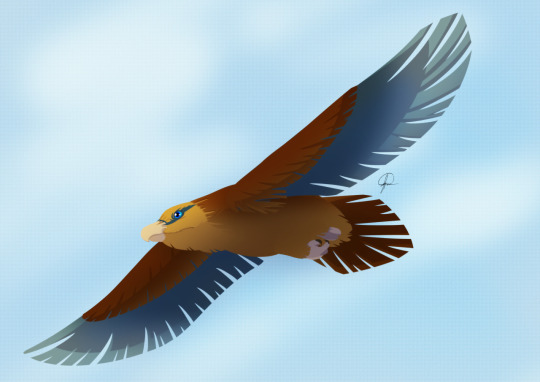
Palaeohierax by @quetzalpali-art!
Alright we're back with a look at the raptors of the Paleogene!
Raptor meaning, of course, bird of prey. Which I wouldn't have to say, except this is a dinosaur blog, and a lot of the time people in dinosaur circles use "raptor" to mean "Dromaeosaur" exclusively. Ironic, given that birds of prey used the word first!

Pulchrapollia by @drawingwithdinosaurs
We've already talked about some of the birds of prey that appeared right after the extinction, such as all the early owls, Qianshanornis, and Danielsraptor. Truth is, being a carnivore is a useful ecology, and birds - having evolved from Paravians like Dromaeosaurs - already have a lot of the tools for chowing down! So, carnivorous birds just keep re-evolving all the time - corvids are sometimes considered raptors, and they're deeply nested within Passerines! And of course, modern roadrunners are essentially mini Velociraptors, but they're cuckoos!
In fact, it seems that most birds alive today evolved from a carnivorous ancestor! All the early-branching members of Telluraves, aka "Core Land Birds" (which includes all passerines and many more besides) are raptorial - owls, hawks, eagles, kites, seriemas, even falcons. And the early ancestors of Passerines and Parrots - things like Halcyornis - were birds of prey as well!
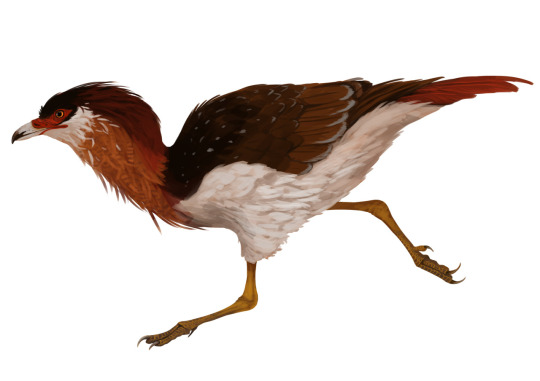
Dynamopterus by @thewoodparable
As we saw with Danielsraptor and Qianshanornis, fast running predatory birds have been a thing since the ash started clearing up from the asteroid. There are just so many small animals to eat and so little time to catch them! Relatives of falcons and seriemas continued to pursue (heh) this lifestyle, and were quite common in the Paleogene fossil record.
In fact, Seriemas - today limited to just a handful of species in South America - had a very successful time of it during the Paleogene and Neogene, with species spread all across the globe. Dynamopterus (sometimes called Idiornis) was from the later Eocene of Europe, and it lived very similarly to living seriemas in its ecosystem! Itaboravis was present in the early Eocene in South America, and we also have Bathornis in North America!
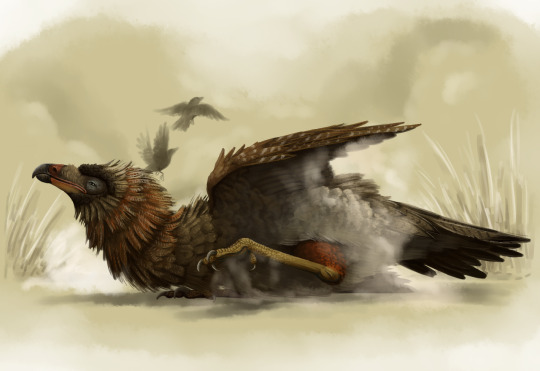
Bathornis by @drawingwithdinosaurs
Bathornis was a very terror-bird-like seriema relative that lived in North America from the Eocene through the Miocene, found in many different environments and at many sizes throughout its existence, including plains and wetlands. Flightless like its terror bird cousins, it had a strong beak to help in catching food and powerful legs for moving quickly across the landscape to catch it!

Ogygoptynx by Apokryltaros/Avancna
Of course, I cannot ignore flighted predatory birds entirely. Though modern ones don't have a lot of fossil relatives (they start appearing in the Oligocene with forms like Palaeohierax), it seems that volant raptors were simply found in other clades - many owls were diurnal, and the relatives of modern parrots and passerines were small carnivores as I mentioned above. With ridges over their eyes to help with glare, these animals could find prey over long distances and fly to them rapidly from their perches - something quite terrifying for the little mammals they ate!
From grasping talons to sickle claws to powerful beaks and eyes, these animals - though small - had major impacts on their environments. Some grew to be so large they would hunt humans - but that's a story for another article.
Sources:
Mayr, 2022. Paleogene Fossil Birds, 2nd Edition. Springer Cham.
Mayr, 2017. Avian Evolution: The Fossil Record of Birds and its Paleobiological Significance (TOPA Topics in Paleobiology). Wiley Blackwell.
88 notes
·
View notes
Text
Perplexicervix paucituberculata Mayr et al., 2023 (new species)
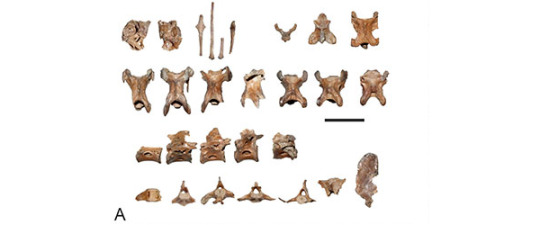
(Type specimen of Perplexicervix paucituberculata [scale bar = 10 mm], from Mayr et al., 2023)
Meaning of name: paucituberculata = little tuberculate [in Latin]
Age: Eocene (Ypresian), 54.6‒55 million years ago
Where found: London Clay Formation, Essex, U.K.
How much is known: Partial skeleton including vertebrae and fragments of the skull. Partial skeletons of two other individuals may also belong to this species.
Notes: P. paucituberculata was an unusual bird that had small bumps covering its neck vertebrae. This feature is shared with the only other species of Perplexicervix that had been previously named, P. microcephalon, as well as with Dynamopterus tuberculatus (a possible close relative to modern seriemas), both of which are from the Eocene of Germany. In fact, the neck vertebrae of P. microcephalon are even more extensively coated in these bumps than those of P. paucituberculata. Similar structures have not been observed in extant birds and their function is unknown. When they were first noticed in fossil birds, it was thought that they may have been the result of an ancient disease that no longer affects birds today. However, the fact that all known specimens of Perplexicervix preserving neck vertebrae have these bumps suggests that they were instead a typical part of their anatomy.
What type of extant bird Perplexicervix was most closely related to is also unclear. Similarities to waterfowl (specifically screamers) had been noted in earlier studies, and the type specimen of P. paucituberculata had been briefly mentioned in a previous paper as an early waterfowl. New specimens, however, indicate that Perplexicervix did not have the characteristic lower jaw anatomy shared by both waterfowl and landfowl. The describers of P. paucituberculata instead note that some of its bones bear noticeable resemblance to those of bustards, a group of often large, ground-dwelling birds that live in Afro-Eurasia and Australasia today. A close relationship with bustards would be very noteworthy if upheld by future research, given that early members of the bustard lineage are otherwise unknown from the Paleogene Period.
Reference: Mayr, G., V. Carrió, and A.C. Kitchener. 2023. On the "screamer-like" birds from the British London Clay: an archaic anseriform-galliform mosaic and a non-galloanserine "barb-necked" species of Perplexicervix. Palaeontologia Electronica 26: 33. doi: 10.26879/1301
#Palaeoblr#Birblr#Dinosaurs#Birds#Perplexicervix paucituberculata#Eocene#Europe#Neoaves#2023#Extinct
37 notes
·
View notes
Note
Were basal cariamiforms like Salmila arboreal?
The hallux of Salmila is quite short, and a similar foot is found in Dynamopterus, so probably not.
0 notes
Text
Fossil Novembirb 11: A New Dawn

Palaeotis by @drawingwithdinosaurs
One of the absolutely best known ecosystems of the Eocene is found at the Messel Pit site of Germany. Deposited in a similar way (via multiple volcanic eruptions over periods of thousands of years) to the Fossil Lake of yesterday, but a few million years later, it shows the end of the early Eocene and the start of the emergence of modern mammalian groups. Lucky for us, it also shows the next stage of bird evolution! This was also the site featured in the first episode of Walking With Beasts, "A New Dawn", though the avifauna was not particularly well represented in that program.
Yes, obviously, Gastornis was in Messel, though as a large ground herbivore than a predator. But there were plenty more birds than that! Lithornis was also here, because it was just as ubiquitous; and there was also the mysterious Palaeoganth Palaeotis. Originally thought to be a relative of Ostriches, then not, and now possibly again, this bird has a strangely intermediate morphology between that of large flightless Palaeognaths and the Lithornithids of the early Paleogene; indicating it may be a transitional form. It would not have been able to fly, given its short wings and lack of keel, and probably fed on small animals in its environment.

Juncitarsus by @thewoodparable
In addition to the Megafowl Gastornis, there was also the early landfowl Paraortygoides, which did not have a crop like living landfowl and as such probably mainly fed on soft plant material. It also had shorter legs than other landfowl relatives at the time, indicating it may have been more similar to living pheasants than fowl that had been around previously.
Even though the Flamingo-Ducks like Presbyornis would stick around well into the Neogene, the first relatives of Flamingos show up at around this time. Juncitarsus was a wading bird, probably just as closely related to living grebes as their cousins flamingos, and had gastroliths in its stomach - allowing it to feed on hard animals it gathered in from the lake. It wasn't the only wader; Messelornis, a wader related to living rails and cranes; is the most common bird at the Messel Pit and was an important generalist in its ecosystem. In addition, the "Snipe-Rail" Rhynchaeites was actually an ibis relative, probing for food with its beak in the substrate around the lake.

Scaniacypselus by Paleo Miguel
Strisores are everywhere at Messel, with relatives of swifts and hummingbirds like Cypseloramphus, Parargornis, and Scaniacypselus, which weren't as adapted to specialized aerial niches as their living relatives. An insectivore with tiny feet, Protocypselomorphus, was also present; as were an early potoo in the form of Paraprefica and an early frogmouth in the form of Masillapodargus.
Strange flight specialists far away from their living ranges aren't the only bizarre features of the ecosystem - Masillastega, a piscivore and relative of living gannets and boobies, was also present at Messel. More relatives of seriemas, like Dynamopterus, Salmila, and Strigogyps showcase how not all Cariamiformes were predators - Strigogyps was an herbivore! The long-legged predator Masillaraptor was present there too, indicating falcons were successful as multiple types of raptors prior to today. The owl Palaeoglaux was a small predatory bird, with ribbon-like feathers in dense layers on its back.
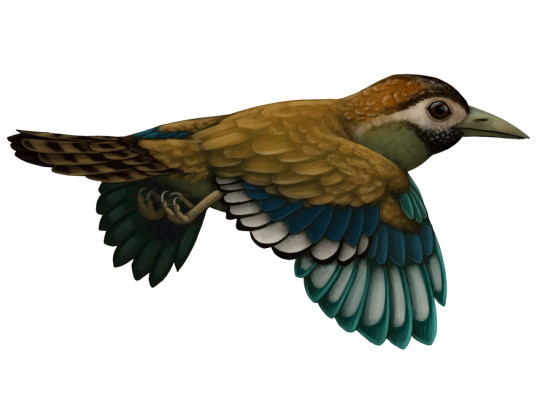
Eocoracias by @drawingwithdinosaurs
There were, of course, many tree dwelling birds in this lacustrine forest, including relatives from both sides of the "core landbirds" family tree. The ecosystem preserves a truly alarming number of mousebirds, including Chascacocolius with a conical beak, and Eoglaucidium with a strangely short tail. Eocoracias, another early roller like those found in Denmark, had iridescent feathers. Early hoopoes like Messelirrisor and early trogons like Masillatrogon show even more examples of more tropical birds showing up in higher latitude locations during this warm period. Messelastur was another possible Parrot/Passerine of prey; as was possibly Pumiliornis. Tons of pre-Passerines were here, too, including the zygodactly-footed Serudaptus, Psittacopes, and Primozygodactylus.
These dinosaurs were living at the end of a time of rapid evolution and diversification for most living things on Earth. However, the hot and humid times never last - as the planet begins to cool, drier ecosystems spread around the planet, and the global tropical forests fade into obscurity. It's time for these new groups of dinosaurs to adapt for new ecosystems...
Sources:
Mayr, 2022. Paleogene Fossil Birds, 2nd Edition. Springer Cham.
Mayr, 2017. Avian Evolution: The Fossil Record of Birds and its Paleobiological Significance (TOPA Topics in Paleobiology). Wiley Blackwell.
Smith, K. T. 2021. The Messel Pit: Window into a Greenhouse World. Geoconservation Research 4(2): 547-556.
119 notes
·
View notes